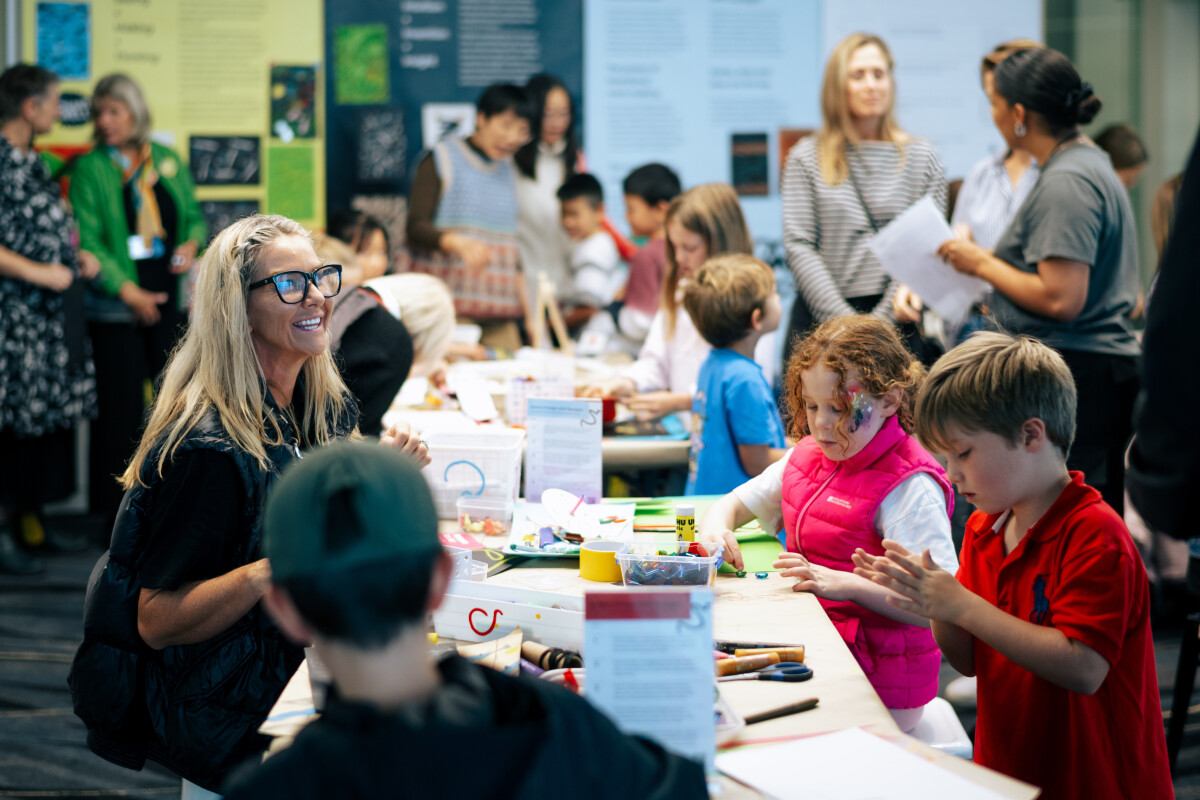
The Squiggla Making Space at the Aotearoa Art Fair 2024. Photo: David St George.
From the Aotearoa Art Fair website:
We spoke with Sue Gardiner, Chair of the Chartwell Charitable Trust, Co-Director of The Chartwell Collection and Co-Director with Karen Gardiner of the Squiggla project, to explore the Trust’s 50-year legacy in supporting Aotearoa’s vibrant visual arts community. Sue shares the story behind the Trust’s founding, its evolution, and its enduring commitment to growing the impact of the visual arts and enabling access to the Chartwell Collection, now housing over 2,000 works. With highlights including significant acquisitions and impactful public art projects, Sue reflects on Chartwell’s role in promoting creative visual thinking and social change. As the Trust celebrates its milestone anniversary, Sue reveals their exciting plans for the future, continuing to inspire and shape the arts landscape in New Zealand.
___
What inspired you to start the Chartwell Trust 50 years ago, and what has kept you motivated over the years?
The Chartwell Project has been an explorer of the visual world for 50 years. My father Rob Gardiner established The Chartwell Trust as a charitable trust to grow, assist and support the visual arts. The Trust established The Chartwell Collection in 1974, inspired by the need for a public art gallery in Hamilton. So, with its home based in Hamilton, the first Collection acquisitions were made with the public art gallery in mind. The thinking around the role of public art galleries and the role of the visual arts in the wider culture encompasses the need for an in-depth investigation, as Rob has written, into the “nature of art working: the making and seeing part, art at work – artworks!” This sense of enquiry honours the work of visual artists who have made artworks important to our culture and who epitomise living a creative life. This focus encompasses Chartwell’s continuing motivation to grow a widening community of people who are attentive and understanding of the mind and body, tools, materials and processes at work in our arts and culture.
How has the Chartwell Collection grown and changed since it was first established in 1974?
Having first been housed in the Waikato, including, between 1982 to 1994, at the Centre for Contemporary Art (CFCA) Chartwell’s own public art gallery, the growing Collection relocated to Auckland Art Gallery Toi o Tāmaki in 1997 with over 200 artworks. A strong trans-Tasman lens on collecting had already developed and continued to grow through ongoing acquisitions and exhibitions, with artists such as Kathy Temin, Peter Tyndall and John Nixon and Emily Kam Kngwarray entering the collection the same year. Chartwell’s early painting acquisitions included expressive, gestural abstraction and, later, non-objective abstraction. Today, the Collection comprises over 2,000 artworks and its holdings include not only paintings, but also an expansive drawing collection, sculptures, installations, archival collections (by Richard Maloy and Daniel Malone for example), performance art, textiles, ceramics, books, audiovisual, prints, photographs and other stimulating objects.
How has your approach to collecting evolved over time?
Drawing on a philosophy around how a contemporary art collection can be an active space of being, seeing, making and thinking, the Chartwell Collection has evolved through a commitment to the art viewing public who are encouraged to turn their attention to the visual artists who have made artworks important to our culture and who epitomise living a creative life. This has meant that the Collection has evolved and responded in ways that offer access to creative actions and to the continual generation of new ideas.
Was there a work of art that got away?
Maybe I can ask this in another way- was there a work of art that was given away?
In 1997, Chartwell was gifted two large murals Godwit/Kuaka by Ralph Hotere (1977) and Prelude to a Journey by Pat Hanly (1977). These murals were first commissioned by the Auckland Airport in the 1970s and now were looking for a new home. They became the first works to enter the Collection at its new base at the Auckland Art Gallery and have come to signify the start of the long and important relationship with the Gallery. While the Hotere mural was able to stay intact within the Collection, Hanly’s work was so large that the artist made the decision to divide the 34 panels into smaller groupings and establish a series of new works. These works were then gifted by Chartwell to other public collections around the country including Te Papa Tongarewa in Wellington and The Hocken in Dunedin, with a set remaining with Chartwell which is currently on display at the Gallery. Some of Chartwell’s related archival material is also on display in the vitrine by the E.H. McCormack Library at Auckland Art Gallery. Curated by Megan Shaw, Philippa Robinson and Freya Elmer, Archive Display | Being, Seeing, Making, Thinking: 50 Years of The Chartwell Project is on until 4 May 2025.
What impact do you hope Chartwell’s projects, like CAST and Squiggla, have on the wider community?
For Chartwell, research is vital for the articulation of the wider impact of the arts. Te Rito Toi – Centre for Arts and Social Transformation (CAST), in the Faculty of Arts and Education at the University of Auckland, research how the arts have the potential to make a more socially just and equitable world through improving the quality of life of all citizens. Arts-based research is urgently needed to deepen this understanding.
Knowing we can all benefit from the interconnectedness of art and a creative life, the Squiggla Project, managed by Karen Gardiner, was developed by Chartwell as an outreach project to encourage open-ended creative participation. So with the artists in the Collection being the inspiring creative leaders, the Squiggla outreach project focusses on intuitive mark making as a playful means for everyone to start to know themselves as creative people. Squiggla calls on us all to turn our attention inwards, towards sense-based creative experiences that are missing from too many lives. Engagement with Squiggla programmes is growing quickly and the team work with an expanding range of organisations and communities and are always pleased to welcome people at the Aotearoa Art Fair.
What are some of the most memorable moments or achievements in Chartwell’s history that stand out to you?
Firstly, Rob was awarded honours in 2000 (ONZM) and 2015 (CNZM) for services to philanthropy and the arts.
With gallerist Sue Crockford and the Gallery team, Rob and I worked on an unusual acquisition in 2007. Black Market Next to My Name, 2007, by Daniel Malone was originally presented at Gambia Castle gallery as a kind of ‘market’ for all of Daniel’s belongings as he headed off overseas. Conceived as part garage sale, part archive, more people realised how significant the exhibition was, not only as a portrait of the artist’s life but as an accumulation of ideas that represented the wider art community. So instead of each item being distributed to a great many people, the work, as one extraordinary entity, entered the Chartwell Collection soon afterwards.
Welcoming Te Pohio o Hine-Moana, 2021, by Raukura Turei into the Collection was a memorable acquisition. It has become a much-loved work on display in the Auckland Art Gallery with many school groups spending time with the six metre- long work, made with onepū (iron sand), raw pigments and oil on linen.
Memorable too have been the four dedicated Chartwell exhibitions presented in The Chartwell Gallery, on level 2 at the Auckland Art Gallery since its redevelopment in 2011. Natasha Conland curated the exhibitions in 2012, 2017 and 2022 with Stephen Cleland curating the Chartwell show in 2014. These on-going exhibitions, held every three years, are significant for their ability to deeply explore a wide range of contemporary art and ideas for audiences in Aotearoa New Zealand.
The opportunity to further celebrate artists as part of our 50th Anniversary programme of exhibitions and events from March 2024 to March 2025 has been memorable in so many ways. With over 100 artworks on loan, reaching a large public gallery audience from Auckland to Queenstown over the year has been hugely significant. All culminated in the recent launch of Being, Seeing, Making, Thinking: 50 Years of The Chartwell Project co-edited by myself and Megan Shaw, and co-published with The Auckland Art Gallery. I’m pleased that the book is available at the Aotearoa Art Fair.
Looking ahead, what are your hopes for the next 50 years of the Chartwell Trust and its impact on the arts?
Hopefully it won’t take another 50 years to witness meaningful progress towards developing a culture which is supportive of the value of the visual arts and committed to encouraging more people to experience and benefit from art making and viewing. We will keep working to achieve this. We will continue to lend our voice to all those who see the future of public art galleries as being fundamental to our way of life and culture and, for Chartwell, to continue to support the exploration of big contemporary ideas that reflect visual arts communities. But, right now, I know the last 50 years of Chartwell activity has delivered change often at an extraordinary pace, with huge heart and extraordinary empathy for the deep belief in the possibilities of a creative future. In that, we are all invested together. Please read more in our new book Being, Seeing, Making, Thinking: 50 Years of The Chartwell Project, available at the Fair, bookshops around the country, and on www.chartwell.org.nz.
